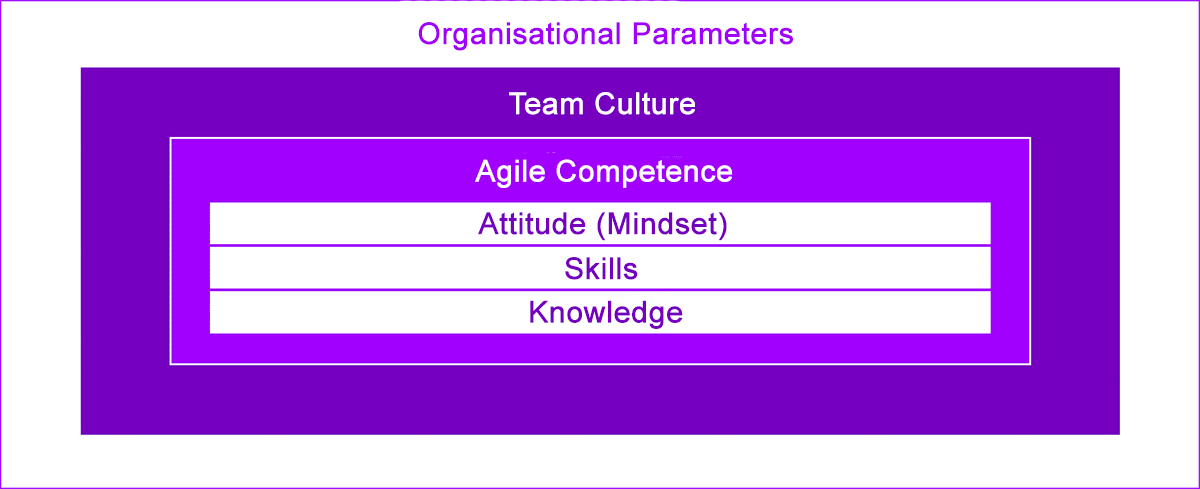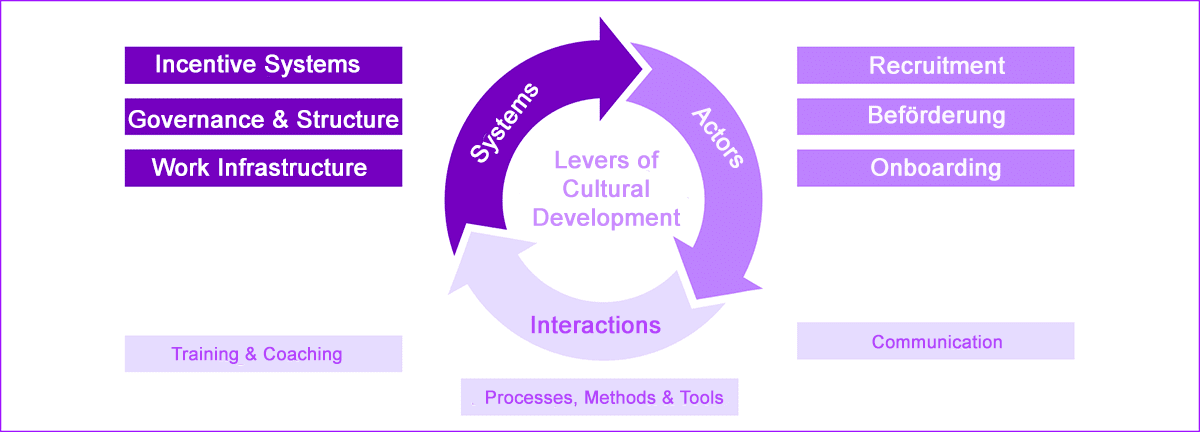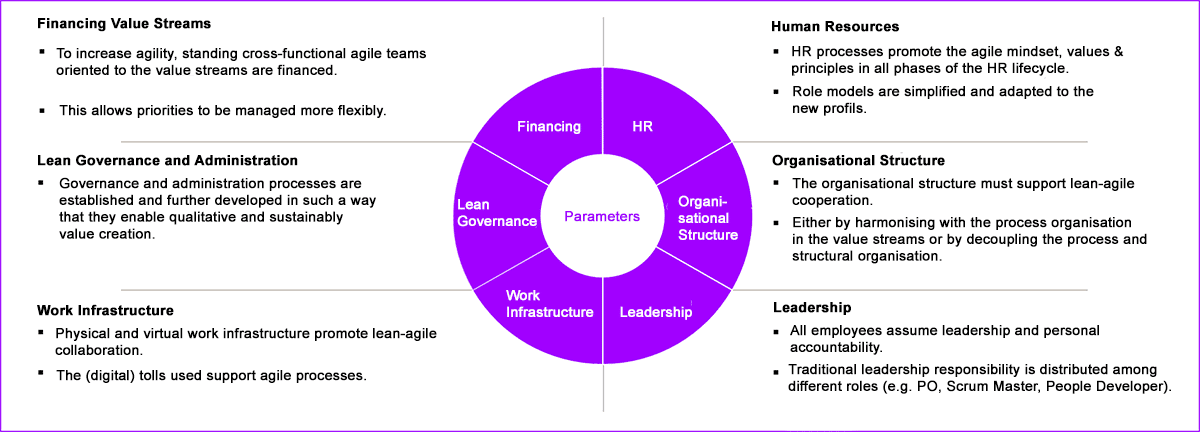Agile is not a mindset
How the transformation from Doing to Being Agile really succeeds
In recent years, countless companies have started an agile transformation. After initial successes, however, most of these organisations realise after 1-3 years on the journey: somehow things have not really improved.
In this context, “not improved” means that the chosen frameworks (e.g. SAFe, LeSS, Scrum, etc.) or the self-developed working methods (e.g. in the form of a “playbook”) are being applied by the organisation. However, the hoped-for effect (e.g. time-to-market, customer satisfaction, employee satisfaction, business value, etc.) does not occur. Many organisations also find that after an initial successful start-up phase, the speed of change decreases significantly or often even stagnates.
The symptoms of this stagnating transformation are as follows:
- Methods are used, but the situation does not improve.
- Employees have joined in initially, but continuous improvement is lacking.
- The processes are adhered to, but the principles behind them are not (e.g. customer perspective, etc.).
- Leadership was initially involved, but now the next “courageous” step is missing.
- Only parts of the organisation are agile, so there is friction with the “old” world.
The gap from Doing to Being Agile as the reason for stagnation
This stagnation is often equated with the gap between Doing Agile and Being Agile. Doing Agile” is understood as the application of agile practices (e.g. SAFe, LeSS, Scrum), while “Being Agile” means that the organisation is actually agile – i.e. has the ability to (proactively) adapt to changes.
The “mindset” is then often proclaimed as the holy grail for overcoming this gap. It is often claimed that “agility is a mindset”, which is why “Being Agile” can also be equated with the “agile mindset”. However, this falls far short and simplifies how the gap between Doing and Being Agile can actually be overcome.
Why agility is not a mindset
A few simple examples clearly show why “Being Agile” cannot simply be equated with the mindset – i.e. the attitude of an individual. A successful, melodious orchestra is made up of talented musicians who, thanks to their professional attitude to music, have the ability to play in it. But this attitude alone is not enough for the orchestra to harmonise well. A successful football team is also built on individuals with a corresponding attitude – but success depends on many other factors. So mindset alone does not help to be a successful team. Organisations, on the other hand, often consist of several teams that have to work together. The more complex the demand for “Being Agile” becomes and the less influence the individual has.
How the leap from Doing to Being Agile really succeeds
In order for the leap from Doing Agile to Being Agile to actually succeed, “agile individuals” are of course needed. In other words, employees who have an “agile competence”. A competence in turn consists of the three dimensions
- mindset,
- knowledge and
- skills.
But individual “agile” employees alone are not enough for the change to “Being Agile” to succeed. Rather, the behaviour patterns in the team must be changed. Only when these individuals apply their competences in practice (i.e. in the team) does the “Being” change. Now, (agile) organisations basically consist of several teams. At the same time, the teams are influenced by the overarching organisational framework. Questions such as: “Who is allowed to decide how?”, “What do incentive structures look like?” or “Who is promoted how and why?” have a great influence on how employees behave in the team.
In order to really make the leap to “Being Agile”, it is not enough to just work on the mindset. Rather, all three levels must be addressed: Agile competence, team culture and organisational parameters.
Level 1: Building an individual agile competence
Building an individual competence succeeds when all three dimensions of this capacity to act are addressed: Mindset, skills and knowledge. Depending on the dimension in which a need for development is identified, different approaches are appropriate.
If it is about the development of knowledge, then it is typically training and education that is chosen as a measure. Learning nuggets, i.e. small learning units, also prove their worth in building knowledge. Be it in the form of short video contributions, blog articles or brown-bag sessions over lunch.
If effective skills are to be developed, it is usually not enough to implement classic training offers. What is needed here are measures that promote the reflective practice of agile practices. This can be a “learning journey” in which short (theoretical) contents are developed collaboratively in order to then practice them in practice and then regularly reflect on them together in coaching sessions. Practising such practices in a “protected setting” such as a game can also help to strengthen agile practice skills.
The development of the mindset – the individual attitude of a person – is, as mentioned, the most demanding. In practice, role plays or decision dilemmas are used here, which are reflected on together. In this way, attitudes towards concrete (action) decisions can be made transparent and developed.
Level 2: Promoting an agile team culture
If the individual employees have built up agile competence, then the necessary basis exists for shaping a corresponding team culture. But competence alone is not enough. Rather, it must be promoted that the team as a whole also behaves in a way that is necessary for “Being Agile”. For this to succeed, three levers are central:
Culture means “how we do things around here”. At its core, culture consists of the interactions within the team. These can be influenced in various ways: Be it through training or coaching, through the introduction of new processes, methods or tools or through the conscious collective reflection of communication (e.g. in the context of a retrospective).
A second lever is the actors in the team itself. This is not only about the competences of the people, but also about which employees are recruited (and how). Or who is promoted (and for what reasons). An important element in shaping the (team) culture is also the way new employees receive onboarding.
Changing systemic conditions are the third lever for team culture. For example, the way certain behaviour is encouraged or punished (incentive/reward systems). But also the decision-making processes (governance) or the work infrastructure have a great influence on the culture.
Level 3: Ensuring the right parameters are in place
As a third dimension for “Being Agile”, the right organisational parameters must also be promoted. This includes (but is not limited to):
- Human Resources
- Organisational structure
- Leadership Behaviour
- Work infrastructure
- Governance and administrative processes
- Financing processes
Conclusion
Many agile transformations are currently stagnating because the leap from Doing to Being Agile is not working. This is often justified by the lack of an agile mindset. But this is a limited view of the problem. Being Agile means that the organisation has the ability to react (proactively) to change. An agile mindset as an individual attitude is only one of several elements for this organisational capability to emerge. Thus, in general, an individual agile competence must be built up, of which mindset is one element. In addition, this individual competence must be translated into corresponding behaviour in the team. Then the right framework conditions are needed so that “Being Agile” is not limited to the team level.
Notes:
If you like the article or want to discuss it, feel free to share it in your network.
Dr Joël Krapf has published two more posts on the t2informatik Blog:

Dr. Joël Krapf
Dr Joël Krapf has been supporting corporate transformations for over 10 years. He currently supports organisations on their digital journey as a senior manager at Accenture. Previously, he was Head of Lean Portfolio and Agile Transformation at Migros, the largest employer in Switzerland. Other positions include PwC and Swiss Post.
Joël holds a PhD in Agile and Transformation from the University of St. Gallen. He has published various books and articles on the topic of agility and is regularly invited as a keynote speaker at conferences. Around 30,000 people follow him and his posts on LinkedIn.
In the t2informatik Blog, we publish articles for people in organisations. For these people, we develop and modernise software. Pragmatic. ✔️ Personal. ✔️ Professional. ✔️ Click here to find out more.




